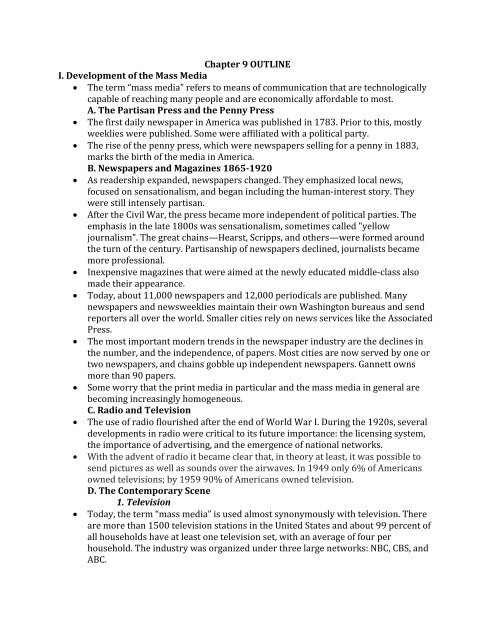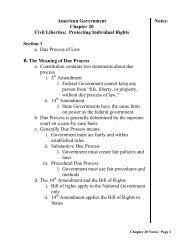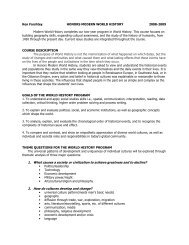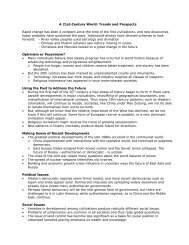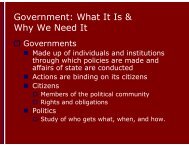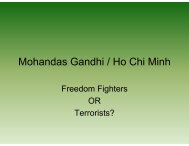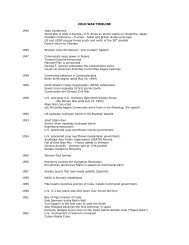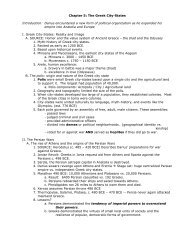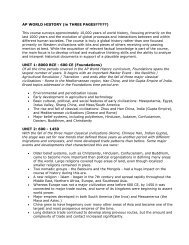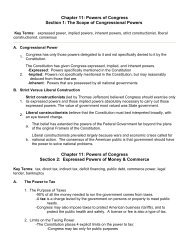Chapter 9 OUTLINE I. Development of the Mass Media ⢠The term ...
Chapter 9 OUTLINE I. Development of the Mass Media ⢠The term ...
Chapter 9 OUTLINE I. Development of the Mass Media ⢠The term ...
Create successful ePaper yourself
Turn your PDF publications into a flip-book with our unique Google optimized e-Paper software.
<strong>Chapter</strong> 9 <strong>OUTLINE</strong><br />
I. <strong>Development</strong> <strong>of</strong> <strong>the</strong> <strong>Mass</strong> <strong>Media</strong><br />
<strong>The</strong> <strong>term</strong> “mass media” refers to means <strong>of</strong> communication that are technologically<br />
capable <strong>of</strong> reaching many people and are economically affordable to most.<br />
A. <strong>The</strong> Partisan Press and <strong>the</strong> Penny Press<br />
<strong>The</strong> first daily newspaper in America was published in 1783. Prior to this, mostly<br />
weeklies were published. Some were affiliated with a political party.<br />
<strong>The</strong> rise <strong>of</strong> <strong>the</strong> penny press, which were newspapers selling for a penny in 1883,<br />
marks <strong>the</strong> birth <strong>of</strong> <strong>the</strong> media in America.<br />
B. Newspapers and Magazines 1865-1920<br />
As readership expanded, newspapers changed. <strong>The</strong>y emphasized local news,<br />
focused on sensationalism, and began including <strong>the</strong> human-interest story. <strong>The</strong>y<br />
were still intensely partisan.<br />
After <strong>the</strong> Civil War, <strong>the</strong> press became more independent <strong>of</strong> political parties. <strong>The</strong><br />
emphasis in <strong>the</strong> late 1800s was sensationalism, sometimes called "yellow<br />
journalism". <strong>The</strong> great chains—Hearst, Scripps, and o<strong>the</strong>rs—were formed around<br />
<strong>the</strong> turn <strong>of</strong> <strong>the</strong> century. Partisanship <strong>of</strong> newspapers declined, journalists became<br />
more pr<strong>of</strong>essional.<br />
Inexpensive magazines that were aimed at <strong>the</strong> newly educated middle-class also<br />
made <strong>the</strong>ir appearance.<br />
Today, about 11,000 newspapers and 12,000 periodicals are published. Many<br />
newspapers and newsweeklies maintain <strong>the</strong>ir own Washington bureaus and send<br />
reporters all over <strong>the</strong> world. Smaller cities rely on news services like <strong>the</strong> Associated<br />
Press.<br />
<strong>The</strong> most important modern trends in <strong>the</strong> newspaper industry are <strong>the</strong> declines in<br />
<strong>the</strong> number, and <strong>the</strong> independence, <strong>of</strong> papers. Most cities are now served by one or<br />
two newspapers, and chains gobble up independent newspapers. Gannett owns<br />
more than 90 papers.<br />
Some worry that <strong>the</strong> print media in particular and <strong>the</strong> mass media in general are<br />
becoming increasingly homogeneous.<br />
C. Radio and Television<br />
<strong>The</strong> use <strong>of</strong> radio flourished after <strong>the</strong> end <strong>of</strong> World War I. During <strong>the</strong> 1920s, several<br />
developments in radio were critical to its future importance: <strong>the</strong> licensing system,<br />
<strong>the</strong> importance <strong>of</strong> advertising, and <strong>the</strong> emergence <strong>of</strong> national networks.<br />
With <strong>the</strong> advent <strong>of</strong> radio it became clear that, in <strong>the</strong>ory at least, it was possible to<br />
send pictures as well as sounds over <strong>the</strong> airwaves. In 1949 only 6% <strong>of</strong> Americans<br />
owned televisions; by 1959 90% <strong>of</strong> Americans owned television.<br />
D. <strong>The</strong> Contemporary Scene<br />
1. Television<br />
Today, <strong>the</strong> <strong>term</strong> “mass media” is used almost synonymously with television. <strong>The</strong>re<br />
are more than 1500 television stations in <strong>the</strong> United States and about 99 percent <strong>of</strong><br />
all households have at least one television set, with an average <strong>of</strong> four per<br />
household. <strong>The</strong> industry was organized under three large networks: NBC, CBS, and<br />
ABC.
Cable television began to expand in <strong>the</strong> 1970s. Today, 51 percent <strong>of</strong> households get<br />
cable, 28 percent have a satellite dish, and 4% have both. Prime time network<br />
programming has lost more than a quarter <strong>of</strong> its audience to cable stations, mainly<br />
FOX, CNN, MSNBC, leading some scholars to suggest that <strong>the</strong> United States is in<br />
transition from an era <strong>of</strong> broadcasting to an era <strong>of</strong> narrowcasting.<br />
2. Newspapers<br />
<strong>The</strong> development <strong>of</strong> television, along with a number <strong>of</strong> o<strong>the</strong>r trends in American life,<br />
has had a major impact on newspapers. First, <strong>the</strong>re has been a marked decline in <strong>the</strong><br />
number <strong>of</strong> cities with more than one newspaper. Ano<strong>the</strong>r important change<br />
affecting newspapers has been <strong>the</strong> spread <strong>of</strong> chain ownership. Increasingly, <strong>the</strong><br />
nation’s newspapers are owned by companies that also own a sizable number <strong>of</strong><br />
newspapers in cities across <strong>the</strong> country.<br />
3. Radio<br />
With <strong>the</strong> development <strong>of</strong> television, radio quickly lost <strong>the</strong> dominant position it had<br />
in American life in <strong>the</strong> 1930s and 1940s.Yet radio continues to be a popular medium<br />
from which many Americans get a good deal <strong>of</strong> <strong>the</strong>ir news. One <strong>of</strong> <strong>the</strong> most<br />
noteworthy trends in American media over <strong>the</strong> last two decades has been <strong>the</strong><br />
growth <strong>of</strong> talk radio.<br />
4. Magazines<br />
Magazines are increasingly marginal as a source <strong>of</strong> news.<br />
E. New <strong>Media</strong><br />
Major examples <strong>of</strong> new media include cable and satellite television, <strong>the</strong> fax, email,<br />
DVDs, and <strong>the</strong> Internet. New media expands <strong>the</strong> range <strong>of</strong> options available to media<br />
consumers in <strong>the</strong> United States<br />
Both <strong>the</strong> Internet and cable television have added many new voices to <strong>the</strong> political<br />
debate, and allowed for greater competition among news outlets. However, <strong>the</strong><br />
competition in cable news should not be over-stated; many <strong>of</strong> <strong>the</strong> cable news outlets<br />
are owned by older, established news organizations.<br />
How will <strong>the</strong> Internet and new media change politics? We’ve already seen changes<br />
in fundraising and <strong>the</strong> newly-important role <strong>of</strong> blogs. Although <strong>the</strong> Internet still lags<br />
behind television in <strong>term</strong>s <strong>of</strong> where Americans get <strong>the</strong>ir news, we may see this<br />
change in <strong>the</strong> near future.<br />
II. What Information Sources Do Americans Rely On?<br />
Television is <strong>the</strong> dominant provider <strong>of</strong> information in American society, and its<br />
dominance is increasing as <strong>the</strong> electronic media progress and expand.<br />
However, while <strong>the</strong>re is no doubt that <strong>the</strong> television is on a lot in <strong>the</strong> typical<br />
American household, in many cases, no one is paying much attention to it. People<br />
are cleaning or cooking or doing <strong>the</strong>ir homework—and <strong>the</strong> TV is little more than<br />
background noise.<br />
Also, <strong>the</strong>re is also a fair amount <strong>of</strong> evidence to indicate that even when people do<br />
watch television news, <strong>the</strong>y do not retain or remember much <strong>of</strong> what <strong>the</strong>y see.
III. <strong>Media</strong> Effects<br />
Early studies done on <strong>the</strong> effects <strong>of</strong> mass media on people's opinions tended to show<br />
that Americans were remarkably resistant to attempts to change <strong>the</strong>ir views. <strong>The</strong><br />
primary reason was selective perception. People were receptive to what <strong>the</strong>y<br />
already believed and screened out what <strong>the</strong>y didn't.<br />
Later studies on television showed various effects.<br />
A. Agenda-Setting<br />
One researcher concluded that while media may not tell people what to think, <strong>the</strong>y<br />
could tell people what to think about. This has been dubbed <strong>the</strong> CNN effect.<br />
B. Priming and Framing<br />
<strong>Media</strong> may also be responsible for directing <strong>the</strong> public to think along certain lines<br />
such as evaluating a president based on a particular issue. This is called priming,<br />
and is similar to <strong>the</strong> idea <strong>of</strong> framing discussed in <strong>Chapter</strong> 5.<br />
C. Socialization<br />
Many critics say that <strong>the</strong> media distorts reality and how children view <strong>the</strong> world.<br />
D. How Strong are <strong>Media</strong> Effects?<br />
Effects such as agenda-setting, priming, and framing depend on both <strong>the</strong><br />
characteristics <strong>of</strong> <strong>the</strong> audience and <strong>the</strong> nature <strong>of</strong> <strong>the</strong> information. <strong>The</strong> media can<br />
have a major impact on public opinion, but whe<strong>the</strong>r <strong>the</strong>y do depends on both who<br />
<strong>the</strong>y are reaching and what <strong>the</strong>y are covering.<br />
IV. <strong>Media</strong> Biases<br />
A. Selection Bias<br />
Selection bias refers to what <strong>the</strong> media presents as news. One type <strong>of</strong> selection bias<br />
is a bias toward <strong>the</strong> negative in <strong>the</strong> media. One political scientist argues that <strong>the</strong><br />
negative tone <strong>of</strong> <strong>the</strong> media has become much more prominent in recent decades.<br />
O<strong>the</strong>rs observe that this has contributed to increasing voter cynicism.<br />
Ano<strong>the</strong>r selection bias is what constitutes news. Events and crises, heroes and<br />
villains, dramatic events, colorful personalities, and sound bites all make better<br />
news than <strong>the</strong>ir counterpoints.<br />
B. Pr<strong>of</strong>essional Bias<br />
Some journalists work a particular beat, but most are generalists who lack specific<br />
substantive expertise. <strong>The</strong>n, too, <strong>the</strong>re is <strong>the</strong> pressure <strong>of</strong> ratings in television news)<br />
<strong>The</strong> lack <strong>of</strong> internal expertise and <strong>the</strong> competitive pressure for ratings contribute to<br />
what is called pack journalism, wherein reporters unanimously decide something is<br />
<strong>the</strong> big story and attack it like wolves tearing apart <strong>the</strong>ir prey.<br />
C. Ideological Bias<br />
Is <strong>the</strong>re a liberal media bias? Liberal viewpoints are over-represented among<br />
practicing journalists, but do <strong>the</strong>se journalists let <strong>the</strong>ir views bias <strong>the</strong>ir reporting? It<br />
is a fact that <strong>the</strong> endorsements <strong>of</strong> today’s newspapers seem to be disproportionately<br />
Republican whereas in <strong>the</strong> past it seemed to be disproportionately liberal and<br />
Democratic.<br />
<strong>The</strong>re is not much evidence <strong>of</strong> a significant liberal or conservative bias in media<br />
coverage <strong>of</strong> politics.
Some studies have concluded that <strong>the</strong> media are harder on Republicans, but o<strong>the</strong>r<br />
studies have shown just <strong>the</strong> opposite.<br />
One researcher concluded that <strong>the</strong> media are harder on incumbents than<br />
challengers.<br />
<strong>The</strong> fact that <strong>the</strong> media are business enterprises pulls <strong>the</strong>m in a conservative<br />
direction. This is especially true as it pertains to <strong>the</strong> very affluent owners <strong>of</strong> CNN<br />
and FOX, Ted Turner and Rupert Murdoch.<br />
<strong>The</strong> CBS “letter” <strong>of</strong> 2004 example will continue to provide fuel to <strong>the</strong> “liberal” tag <strong>of</strong><br />
<strong>the</strong> media. In September 2004, CBS News and its venerable anchor Dan Ra<strong>the</strong>r<br />
suffered a major blow to <strong>the</strong>ir credibility, admitting <strong>the</strong>y were duped by <strong>the</strong> source<br />
<strong>of</strong> a story purporting to show that George W. Bush was given favored treatment in<br />
avoiding <strong>the</strong> draft during <strong>the</strong> Vietnam War in <strong>the</strong> 1970s.<br />
D. Prospects for Change<br />
As <strong>the</strong> network system declines, more independent stations begin operation, and<br />
<strong>the</strong> news media continue to advance, we may see <strong>the</strong> development <strong>of</strong> numerous<br />
specialized informational channels that reflect values different from <strong>the</strong><br />
entertainment values that have shaped <strong>the</strong> modern mass media.<br />
Selection biases might gradually become undermined by technological change.<br />
V. A Word about Entertainment <strong>Media</strong><br />
Much <strong>of</strong> what are generally thought <strong>of</strong> as entertainment media—movies, situation<br />
comedies, detective shows, soap operas—may also contain material that has<br />
significant political implications. Over <strong>the</strong> last 20 years, for example, American<br />
attitudes toward homosexuality have become significantly more tolerant and even<br />
approving, in ways that have important consequences for such issues as gay rights<br />
and same-sex marriage. And while this change has probably taken place for a<br />
number <strong>of</strong> reasons, one major source has almost certainly been <strong>the</strong> way that gay and<br />
lesbian characters are portrayed in movies and on television.<br />
VI. <strong>The</strong> <strong>Media</strong> and Electoral Politics<br />
A. Campaign Coverage<br />
Critics charge <strong>the</strong> media with providing far too much coverage <strong>of</strong> candidate<br />
personalities and not enough <strong>of</strong> <strong>the</strong> issues. In recent years, <strong>the</strong> media has<br />
increasingly treated elections as horse races, with an emphasis on who is winning<br />
and who is losing.<br />
B. <strong>The</strong> Conventions<br />
Since <strong>the</strong> primary process for nominating candidates was instituted in 1972, <strong>the</strong><br />
conventions are not nearly as important as in earlier eras, and media coverage has<br />
dropped accordingly.<br />
Consequently, <strong>the</strong> parties now treat <strong>the</strong> conventions as huge infomercials, with <strong>the</strong><br />
networks providing less coverage. In 2000, MTV provided more coverage than <strong>the</strong><br />
three networks combined.
C. <strong>The</strong> Presidential Debates<br />
<strong>The</strong> Commission on Presidential Debates was established in 1987 to ensure that<br />
debates, as a permanent part <strong>of</strong> every general election, provide <strong>the</strong> best possible<br />
information to viewers and listeners. Its primary purpose is to sponsor and produce<br />
debates for <strong>the</strong> United States’ leading presidential and vice-presidential candidates<br />
and to undertake research and educational activities relating to <strong>the</strong> debates. <strong>The</strong><br />
organization, which is a nonpr<strong>of</strong>it, nonpartisan corporation, sponsored all <strong>the</strong><br />
general election debates in 1988, 1992, 1996, 2000, and 2004.<br />
<strong>The</strong> debates also don't hold good news for independent and third party presidential<br />
aspirants. <strong>The</strong> nonpartisan commission established a rule that explicitly states that<br />
presidential candidates must have an average <strong>of</strong> at least 15 percent support in five<br />
national polls in order to take part in <strong>the</strong> fall debates.<br />
Moreover, <strong>the</strong>re are indications that performance in <strong>the</strong> debates can sway <strong>the</strong><br />
undecided voter.<br />
As in campaign coverage generally, <strong>the</strong> first question <strong>the</strong> media raise about debates<br />
is "who won?" If a candidate has misspoken, that <strong>of</strong>ten becomes <strong>the</strong> subject <strong>of</strong> a<br />
feeding frenzy. With polls showing that <strong>the</strong> percent <strong>of</strong> Americans were still<br />
undecided between John Kerry and George Bush, in <strong>the</strong> fall <strong>of</strong> 2004, <strong>the</strong>ir respective<br />
performances in <strong>the</strong> three debates agreed upon some contend may have ultimately<br />
decided <strong>the</strong>ir fate in <strong>the</strong> elections.<br />
VII. <strong>Media</strong> Coverage <strong>of</strong> Government<br />
<strong>The</strong> media views much <strong>of</strong> what government does as dull, and as a result, it goes<br />
looking for what is less dull.<br />
A. Emphasis on <strong>the</strong> President (and O<strong>the</strong>r Personalities)<br />
<strong>The</strong> media pay more attention to <strong>the</strong> president than to Congress. He is one person<br />
and has personality and character.<br />
By focusing on personalities, <strong>the</strong> media encourages individualism and discourages<br />
teamwork.<br />
B. Emphasis on Conflict<br />
<strong>The</strong> media emphasizes conflict, name-calling, and <strong>the</strong> like over thoughtful,<br />
intelligent discussion.<br />
C. Emphasis on <strong>the</strong> Negative<br />
From <strong>the</strong> media's standpoint, what government does well is less newsworthy than<br />
what government does badly.<br />
D. <strong>The</strong> Response: Exaggerated Concern with <strong>the</strong> Press<br />
Government <strong>of</strong>ficials have become more concerned with <strong>the</strong> press than with <strong>the</strong><br />
voters.


